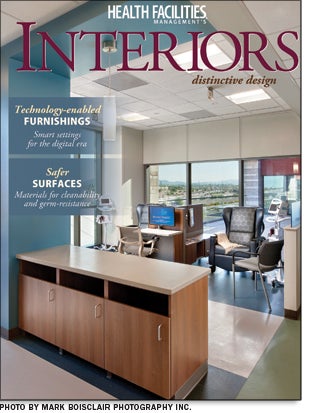Interiors
 |
| Technology-Enabled Furnishings By Amy Eagle Safer Surfaces By Amy Eagle |
If you find it difficult to keep up with the pace of change in personal technology such as computers, smartphones and tablet devices, pity the health care architects, interior designers, information technology and environmental services professionals who must continuously modify and maintain the patient care environment to enable the use of these and other electronic gadgets.
As challenging as this situation is, health care designers must view this as an opportunity rather than a burden. Giving patients greater access to the technologies that now are so pervasive in our daily lives is imperative.
Still, the challenge remains how to do this without interfering in the caregiver-patient relationship. In this installment of Interiors, we explore the concerted efforts of those in the furniture design community to support health care organizations that remain committed to creating environments of positive change when it comes to enabling patient access to their personal technology.
In our report titled "Technology-Enabled Furnishings," we explore manufacturer innovations that make it easier for patients to remain connected to their online world even as they are temporarily out of commission in many other aspects of their lives. Likewise, the report examines many of today's furnishings that support nurses and other caregivers who rely on wireless mobile technologies to help them provide efficient, effective care.
In our second feature — "Safer Surfaces" — Amy Eagle covers a plethora of materials, products and surfaces designed to enhance environmental safety. From paints to surfaces with antimicrobial properties, the focus squarely is on reducing the chances that dangerous pathogens will be passed from caregiver to patient or vice versa due to surface contact. In addition, the report explores ways many products are making it easier for environmental services teams to clean and disinfect surfaces more easily.
In this era of continuous and accelerated change, the health care environment must keep pace.
Bob Kehoe
Associate Publisher,
Health Facilities Management
A note of acknowledgment
The editors would like to thank the many vendors and health care design firms who participated in this supplement. The following sources provided images used in this project: Albert Kahn Associates (Detroit), Benjamin Moore (Montvale, N.J.), Cannon Design (Chicago), CertainTeed (Valley Forge, Pa.), Construction Specialities (Lebanon, N.J.), CuVerro (Louisville, Ky.), DuPont (Wilmington, Del.), HDR Architecture (Omaha, Neb.), Herman Miller (Zeeland, Mich.), InPro Corp. (Muskego, Wis.), Kahler Slater (Milwaukee), Nemschoff (Sheboygan, Wis.), PURETi (New York City), Rocky Mountain Hardware (Hailey, Idaho), Sedia Sytems (Chicago) and Steelcase Inc. (Grand Rapids, Mich.).




